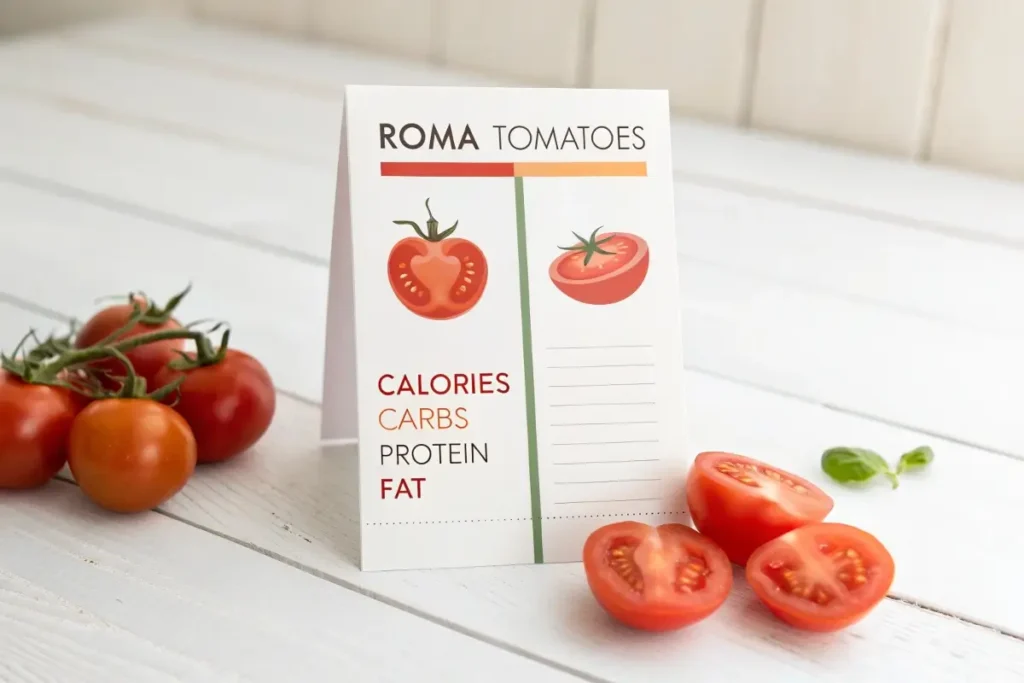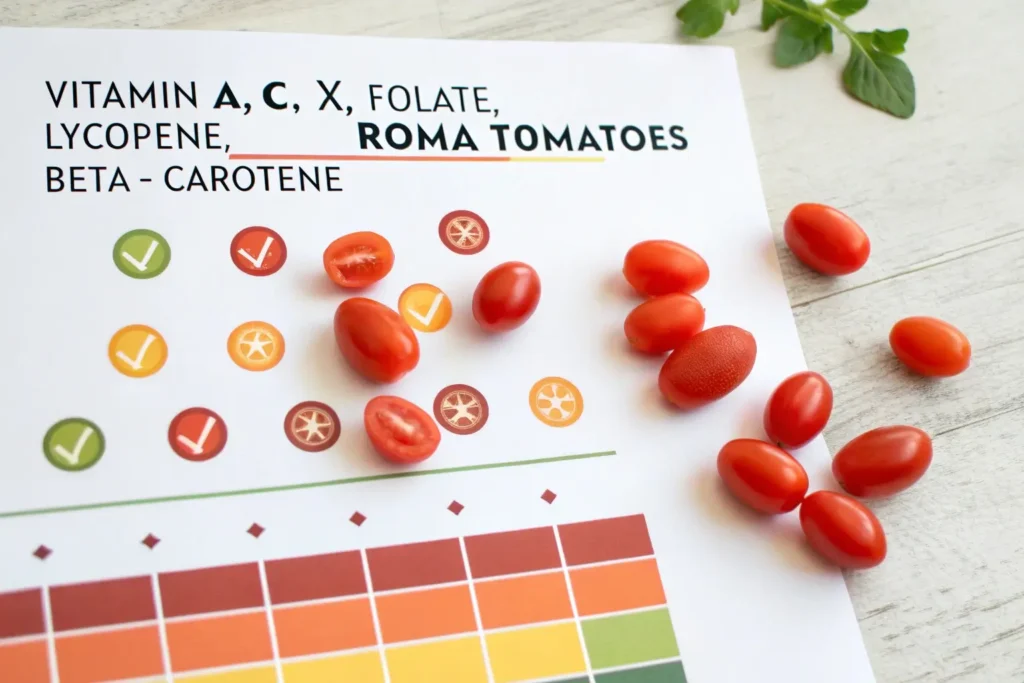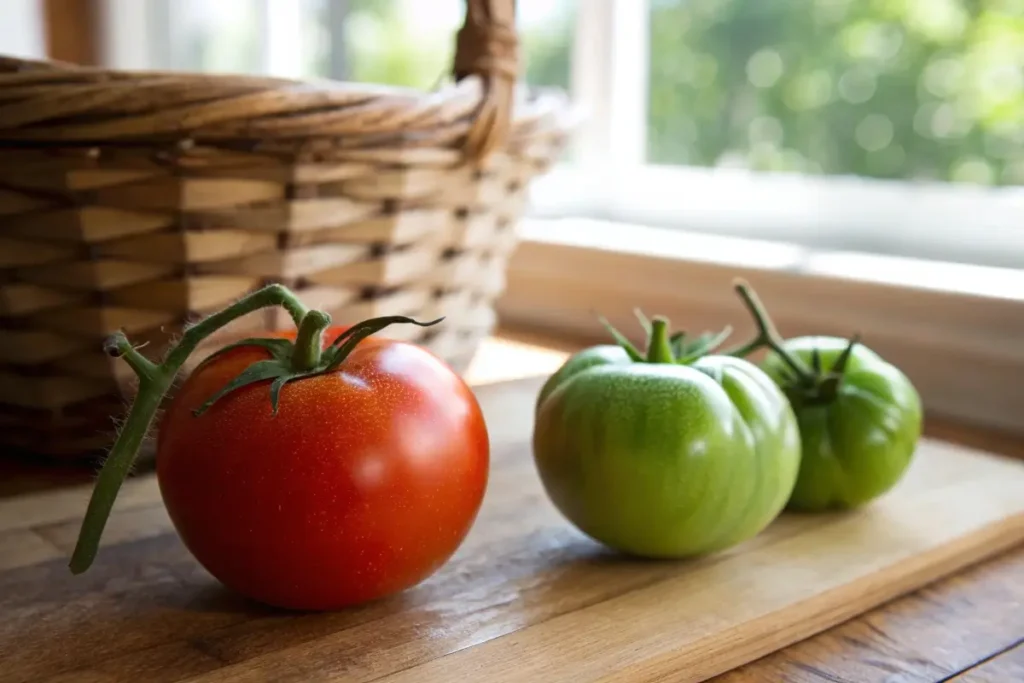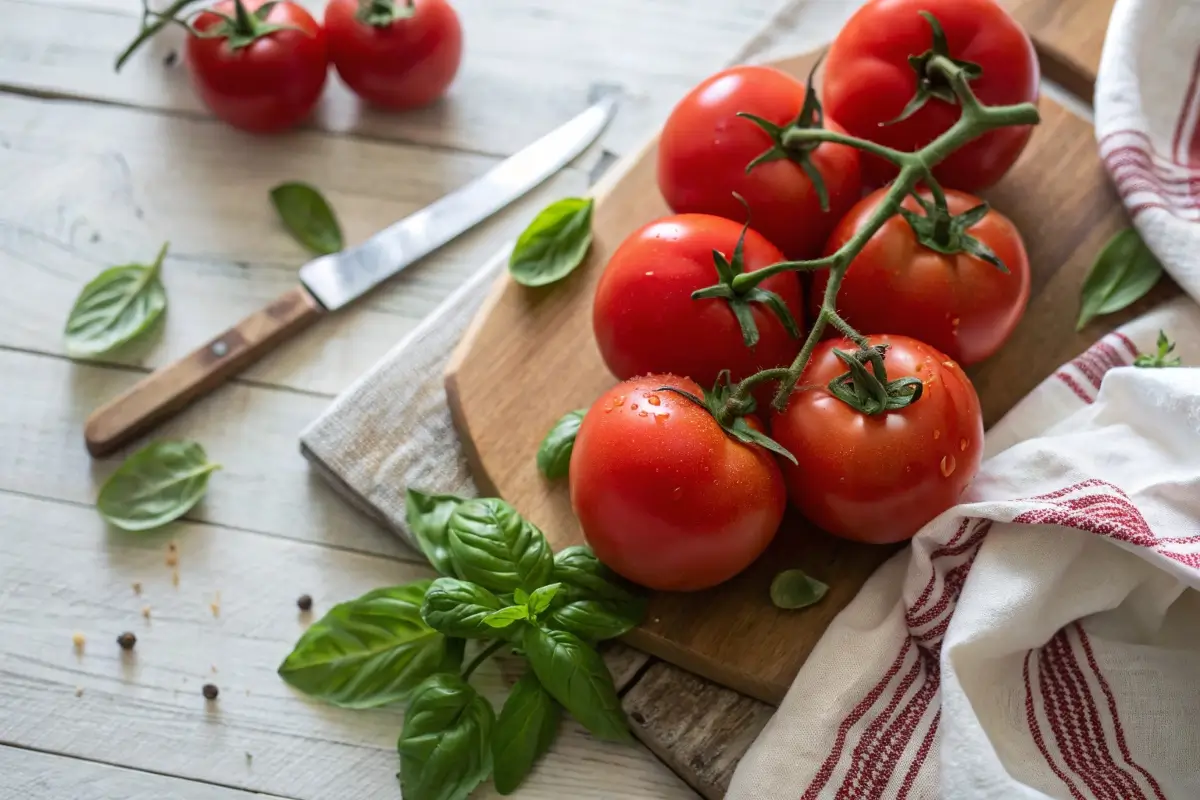Roma tomatoes are a staple ingredient in many kitchens, loved for their bold flavor, versatility, and health benefits. This article dives into the nutritional wonders of Roma tomatoes, from their macronutrients to their role in supporting overall health. Whether you’re a curious cook or a nutrition enthusiast, you’ll discover why these vibrant red fruits are a must-have in your diet. Let’s explore their rich nutritional profile, health benefits, and tips for incorporating them into your meals!
Introduction to Roma Tomatoes
Overview of Roma Tomatoes
Roma tomatoes, also called plum tomatoes, are a variety of tomato prized for their dense flesh and low moisture content. They’re oval-shaped, with a vibrant red color that hints at their rich antioxidant content. Known for their mildly tangy flavor, Roma tomatoes are widely used in sauces, pastes, and fresh dishes.
Compared to their rounder cousins, Roma tomatoes have fewer seeds and thicker walls, making them perfect for cooking. But they’re not just about taste—they pack a nutritional punch too!
Distinguishing Features from Other Tomato Varieties
What sets Roma tomatoes apart from other types like cherry or heirloom tomatoes? Their firm texture and balanced sugar-to-acid ratio make them ideal for a variety of recipes. While larger beefsteak tomatoes are often used for slicing and eating raw, Roma tomatoes shine when used in culinary creations like marinara sauce or roasted vegetable medleys.
Nutritionally, they’re a powerhouse, offering a rich dose of vitamins, minerals, and antioxidants while being low in calories. These unique qualities have earned Roma tomatoes a spot in both home kitchens and gourmet recipes around the globe
Macronutrient Profile of Roma Tomato Nutrition

Caloric Content and Serving Sizes
When it comes to keeping your meals light and healthy, Roma tomatoes are a great choice. One medium Roma tomato has only about 37 calories, making it a guilt-free addition to any dish. A typical serving size, which is around 100 grams, contains roughly 18 calories. This low-calorie profile is perfect for people watching their weight or counting calories.
Whether you’re snacking on them raw or adding them to your favorite recipe, Roma tomatoes help you enjoy flavorful food without packing on the pounds.
Carbohydrates: Natural Sugars and Dietary Fiber
Roma tomatoes are naturally low in carbs, containing about 4 grams of carbohydrates per serving. These carbs include natural sugars that provide a subtle sweetness, along with dietary fiber that aids digestion. A single Roma tomato has about 1 gram of fiber, which helps keep your digestive system running smoothly.
Including Roma tomatoes in your meals is a tasty way to meet your daily fiber needs. Fiber not only improves digestion but also helps you feel fuller for longer, making it easier to maintain a balanced diet.
Protein Content in Roma Tomatoes
While not a significant source of protein, Roma tomatoes do contain small amounts—around 0.8 grams per serving. Although this might seem modest, it adds up when combined with other nutrient-dense foods. Adding Roma tomatoes to protein-rich dishes like beans or chicken can enhance the meal’s overall nutritional value.
Fat Content: Minimal but Notable Aspects
Roma tomatoes are virtually fat-free, containing less than 0.2 grams of fat per serving. This makes them an excellent choice for anyone following a low-fat diet. Plus, their high water content keeps you hydrated while contributing to a light, satisfying meal.
Micronutrient Richness in Roma Tomato Nutrition

Vitamins: A, C, K, and Folate
Roma tomatoes are packed with essential vitamins. They’re a fantastic source of vitamin C, which supports your immune system and helps your body absorb iron. Just one medium Roma tomato provides around 20% of your daily vitamin C needs!
Additionally, they’re rich in vitamin A, crucial for maintaining healthy vision and skin. You’ll also find vitamin K, which plays a key role in blood clotting and bone health, and folate, essential for cell function and tissue growth.
Minerals: Potassium, Magnesium, and Iron
In terms of minerals, Roma tomatoes are a powerhouse. Potassium is one of the standout minerals, helping to regulate blood pressure and maintain proper muscle function. A single serving offers around 250 milligrams of potassium, which is about 7% of your daily needs.
They also contain smaller amounts of magnesium, which supports nerve and muscle function, and iron, which is vital for healthy blood cells. Adding Roma tomatoes to your meals is a simple way to boost your mineral intake.
Antioxidants: Lycopene and Beta-Carotene
One of the most notable aspects of Roma tomato nutrition is their high antioxidant content, particularly lycopene. Lycopene is what gives tomatoes their bright red color, and it’s linked to numerous health benefits, including reduced inflammation and a lower risk of certain cancers.
Beta-carotene, another powerful antioxidant, supports skin health and immune function. Interestingly, cooking Roma tomatoes can increase the bioavailability of lycopene, making sauces and soups not only delicious but also extra nutritious.
Health Benefits of Roma Tomato Nutrition
Cardiovascular Health and Lycopene
Incorporating Roma tomatoes into your diet can be beneficial for heart health. They are rich in lycopene, an antioxidant that may help lower the risk of heart disease. Lycopene works by reducing LDL cholesterol levels and protecting cells from damage. Cooking Roma tomatoes increases the bioavailability of lycopene, making dishes like tomato sauce not only tasty but also heart-friendly.
Anti-Inflammatory Properties
Roma tomatoes possess anti-inflammatory properties due to their high content of antioxidants, including vitamin C and lycopene. These compounds help combat oxidative stress in the body, potentially reducing inflammation and lowering the risk of chronic diseases. Including Roma tomatoes in your meals can be a delicious way to support your body’s natural defenses.
Cancer Prevention Potential
The antioxidants found in Roma tomatoes, particularly lycopene, have been studied for their potential role in cancer prevention. Lycopene may help protect cells from damage and reduce the growth of certain cancer cells. While more research is needed, adding Roma tomatoes to your diet is a flavorful way to contribute to overall health.
Digestive Health Support
With their high fiber content, Roma tomatoes aid in digestion and promote a healthy gut. Dietary fiber helps regulate bowel movements and can prevent constipation. Including Roma tomatoes in your diet supports digestive health and contributes to overall well-being.
Culinary Uses and Nutritional Impact

Raw Consumption: Salads and Salsas
Roma tomatoes are perfect for fresh dishes due to their firm texture and rich flavor. They add a burst of nutrition to salads and salsas, providing vitamins A and C, potassium, and antioxidants. Enjoying them raw preserves their vitamin C content, which supports the immune system and skin health.
Cooking Methods: Sauces, Roasting, and Baking
Cooking Roma tomatoes enhances certain nutrients, like lycopene, making them more available for absorption. Preparing sauces, roasting, or baking these tomatoes not only deepens their flavor but also boosts their health benefits. Including cooked Roma tomatoes in your meals can contribute to heart health and provide anti-inflammatory benefits.
Effect of Cooking on Nutrient Bioavailability
While cooking increases lycopene availability, it’s important to note that some nutrients, like vitamin C, are sensitive to heat and may decrease during cooking. To maximize the nutritional benefits of Roma tomatoes, incorporate both raw and cooked forms into your diet. This approach ensures you receive a balance of nutrients, supporting overall health.
FAQs
Are Roma tomatoes healthier than regular tomatoes?
Roma tomatoes stand out for their dense texture and lower water content, making them an excellent choice for cooking. Nutritionally, they are similar to other tomato varieties, offering vitamins A and C, potassium, and antioxidants. However, their high lycopene concentration makes them a top pick for supporting heart health and reducing inflammation.
How does cooking affect the nutritional value of Roma tomatoes?
Cooking Roma tomatoes enhances the bioavailability of lycopene, a powerful antioxidant. This process makes it easier for your body to absorb and use lycopene effectively. However, some heat-sensitive nutrients like vitamin C may slightly decrease during cooking. To get the best of both worlds, enjoy Roma tomatoes raw in salads and cooked in sauces or soups.
Can consuming Roma tomatoes improve skin health?
Yes, Roma tomatoes are rich in vitamins C and A, which are known to support healthy skin. Vitamin C promotes collagen production, while vitamin A helps maintain smooth, vibrant skin. Lycopene, another key nutrient, also helps protect the skin from damage caused by UV rays.
What is the lycopene content in Roma tomatoes?
Roma tomatoes are an excellent source of lycopene, containing about 4.6 milligrams per 100 grams. This antioxidant is associated with numerous health benefits, including reduced inflammation and a lower risk of certain cancers.
Incorporating Roma Tomato Nutrition into a Balanced Diet
Daily Recommended Intake
While there’s no strict limit on how many Roma tomatoes you can eat, including 1-2 medium-sized Roma tomatoes in your daily meals can provide a healthy dose of vitamins, minerals, and antioxidants. They are low in calories and versatile enough to fit into any meal plan.
Combining with Other Nutrient-Dense Foods
Pairing Roma tomatoes with other nutrient-rich foods enhances their nutritional value. For example, combining them with healthy fats like avocado or olive oil can improve the absorption of fat-soluble vitamins and lycopene. Adding Roma tomatoes to dishes with lean protein, whole grains, or leafy greens creates a well-rounded, nutritious meal.
Potential Allergies and Sensitivities
While Roma tomatoes are generally safe for most people, some individuals may experience allergies or sensitivities. Symptoms like itching, swelling, or digestive discomfort after consuming tomatoes should be taken seriously. If this occurs, consult with a healthcare provider to determine the cause.
Selecting and Storing Roma Tomatoes for Maximum Nutrition

Choosing the Freshest Roma Tomatoes
To enjoy the full benefits of Roma tomato nutrition, it’s essential to choose fresh, high-quality tomatoes. Look for Roma tomatoes that are firm to the touch with smooth, unblemished skin. They should have a deep red color, which indicates ripeness and a higher concentration of lycopene. Avoid tomatoes with soft spots, cracks, or signs of mold, as these may indicate spoilage.
If you’re shopping at a local market, give them a gentle squeeze to ensure they’re firm but not hard. Fresh Roma tomatoes also emit a slightly sweet and earthy aroma near the stem.
Proper Storage Techniques to Preserve Nutrients
Storing Roma tomatoes correctly helps maintain their flavor and nutritional value. For tomatoes that are not fully ripe, leave them at room temperature away from direct sunlight until they reach peak ripeness. Once ripe, store them in the refrigerator to extend their shelf life by several days. However, refrigerating tomatoes can sometimes affect their texture and flavor, so allow them to return to room temperature before eating.
For long-term storage, consider freezing Roma tomatoes. Blanching them first helps preserve their vitamins and antioxidants. These frozen tomatoes can later be used in sauces and soups without losing much of their nutritional value.
Seasonality and Its Effect on Nutritional Value
Roma tomatoes are typically in season during the summer months, which is when they’re most flavorful and nutrient-rich. Off-season tomatoes are often grown in greenhouses or imported, which can result in a slight reduction in their vitamin content. Whenever possible, choose locally grown, seasonal Roma tomatoes for the best taste and nutrition.
Delicious Recipes Using Roma Tomato Nutrition
1. Classic Roma Tomato Bruschetta
Ingredients:
- 4 Roma tomatoes (diced)
- 1 clove garlic (minced)
- 2 tbsp olive oil
- 1 tbsp balsamic vinegar
- Fresh basil leaves (chopped)
- Salt and pepper to taste
- Sliced baguette (toasted)
Instructions:
- Mix diced Roma tomatoes, garlic, olive oil, balsamic vinegar, and basil in a bowl. Season with salt and pepper.
- Spoon the mixture onto toasted baguette slices.
- Serve immediately for a simple, fresh appetizer.

2. Roasted Roma Tomato Soup
Ingredients:
- 6 Roma tomatoes (halved)
- 1 medium onion (sliced)
- 2 cloves garlic (whole)
- 2 cups vegetable broth
- 2 tbsp olive oil
- 1 tsp dried thyme
- Salt and pepper to taste
Instructions:
- Preheat oven to 400°F (200°C). Place tomatoes, onion, and garlic on a baking sheet. Drizzle with olive oil, thyme, salt, and pepper.
- Roast for 25-30 minutes until the tomatoes are soft and slightly caramelized.
- Blend the roasted ingredients with vegetable broth until smooth. Heat on low before serving.

3. Roma Tomato and Avocado Salad
Ingredients:
- 4 Roma tomatoes (sliced)
- 1 ripe avocado (sliced)
- 1/4 red onion (thinly sliced)
- 2 tbsp olive oil
- 1 tbsp lemon juice
- Salt and pepper to taste
Instructions:
Serve as a light, refreshing side dish
Arrange Roma tomatoes, avocado, and red onion on a plate.
Drizzle with olive oil and lemon juice. Season with salt and pepper.

Conclusion
Roma tomatoes are much more than just a simple kitchen ingredient; they are a nutritional powerhouse packed with health benefits. From supporting heart health with their rich lycopene content to aiding digestion with their dietary fiber, these versatile tomatoes can significantly enhance your meals while contributing to your overall well-being. Whether you enjoy them fresh in salads and salsas or cooked into flavorful sauces, Roma tomatoes offer a perfect balance of taste and nutrition.
Incorporating Roma tomatoes into your daily meals is an easy and delicious way to boost your intake of essential vitamins, minerals, and antioxidants. Their low calorie and fat content make them an ideal choice for anyone striving to maintain a healthy lifestyle. Plus, their natural sweetness and vibrant color add a touch of freshness to any dish.
By understanding Roma tomato nutrition and the best ways to select, store, and prepare them, you can maximize their benefits and get the most out of this superfood. So, whether you’re looking to enhance your heart health, improve your digestion, or simply enjoy a nutrient-rich meal, Roma tomatoes are here to deliver.
If you’re inspired to explore even more healthy ingredients and recipes, be sure to check out our other articles for ideas that will keep your meals exciting and nutritious!


5 thoughts on “How Roma Tomatoes Boost Your Health: Nutrition Facts You Need to Know”